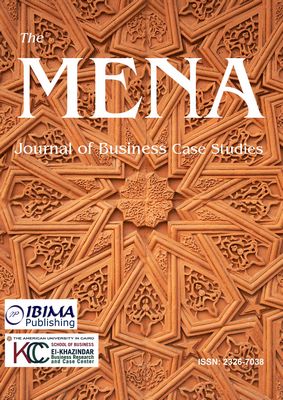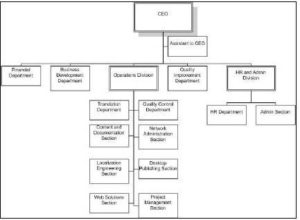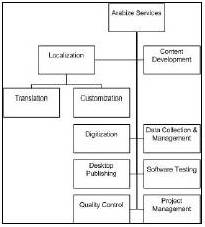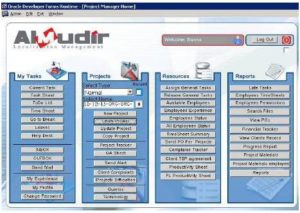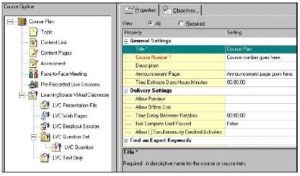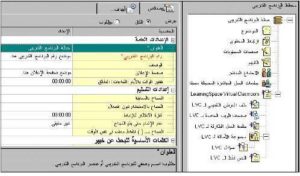Order
As soon as a notification is received from the customer, the project manager starts initiating the project internally at Arabize. The project manager coordinates with Arabize Translation Department manager and section heads to select project resources based on the availability of localizers and their skill levels, which are documented and updated continually. AlMudir workflow system shows the availability of localizers, who are booked on a first-come-first-served basis. Project resources selection factors include experience and time frame. The project manager divides the project into batches, e.g. 5000 words to 5 batches, and then the status is monitored per batch. The project start date depends on the release of the product English version, as it should be available before the translation/localization starts. There is an alias email that is included in project communications, an alias is set for each customer including the PM(s) handling the project and the backup PM(s). Currently, a new system is needed to allow the project manager to monitor the progress of work without inputs from the working resources. While the above description refers only to the Language production team, the same cycle also applies to the other project types, such as Content and DTP.
The project manager arranges the project kick-off meeting. AlMudir workflow system is used from the outset of the project. The interface of AlMudir Project Manager-Home and AlMudir Project Manager-Project are depicted in Figures 4 and 5, respectively. The project is created and resources are requested and assigned on the system. The project manager allocates resources from other sections or freelancers if needed. The decision of freelancer outsourcing occurs based on the project need and available experience and resources. Freelancers are selected based on commitment, quality and experience. The freelancer database includes both individuals and smaller companies (subcontractors) and is constantly updated. In the past years, freelancers cost more than internal resources. In some cases, freelancers cost is not different from internal resources. The project manager negotiates with the customer for time extensions as necessary. Some time reserve is left for unforeseen events.
Production
During the production phase, the project manager ensures any issues are managed on a case-by-case basis. For example, actions are planned as necessary to compensate for time lost if needed. The project manager ensures the project progresses as planned. Sometimes customers’ instructions are not accurate, and open issues in project are tracked by email. There are regular conference calls with the customer’s language specialist, project manager, vendor manager (customer representative) with minutes of meeting.
When the translator presses “start” on the AlMudir system, time starts counting while they carry out their tasks. The Language Section Head finally records comments and signs off and also records a project diary with positives and negatives. The customer provides references on technical subjects, such as explaining the product. If difficult terms are encountered by Arabize translators, the customer is consulted. Glossaries from old work are also consulted. Production tasks are often carried out on remote customer servers, which is challenging because of continual monitoring by the customer and effect of internet connection reliability issues. Some problems occur, such as the file will not open, and in this case the help of localization engineer is necessary.
Quality Control (QC)
The Translation section head reviews and checks the tasks done by translators and reviewers before the QC team performs the usual linguistic inspection activities. Then the findings are recorded on the AlMudir system. AlMudir tracks the performance of every localizer and reviewer. Customer complaints are also recorded on the system so that the QC team performs the related investigation cycle. In SAP projects, quality activities include applying QETT (Quality Evaluation Tool for Translation), which is the linguistic sign-off required by SAP, as well as internal QC sheets. The QC function is also responsible for updates of SAP support package.
Delivery to the Customer
To illustrate localization project deliverables, an item is shown before and after localization to Arabic in Figures 6 and 7, respectively. The project manager is responsible for delivering to the customer, getting the customer’s feedback and closing all open points with the customer. The PM delivers the project files after ensuring they open normally and generally there are no technical issues with them and all customer requirements were met. The Project Management Section Head signs all invoices after review. Delivery notes that contain open issues at delivery time are transferred to the customer. Post-mortem report is initiated by PMs after the project delivery. It includes information about best practices and problems with customer/lessons learned.
The project manager ensures that the project backup activity occurs daily, weekly and/or at the end of a project. If the project period is less than one week, the team leader saves the project files locally on his/her PC (Daily). If the project period is more than one week, the project manager instructs the backup operator to back up the project (Weekly). At the end of each project, the project manager saves the whole project on the backup server and notifies the backup operator of the project’s location on the backup server. Between 60 to 90 days after a project’s completion, the backup operator saves the backup on tapes. After a minimum of three months, the project manager clears the project folder located on the network and keeps only the deliverables on the backup server.
Competitive Advantage
In response to the growing demand for localization services in the Middle East and North Africa (MENA) market, Arabize offers premium quality localization services in the target languages of Arabic, English and German. In the MENA region there are many variations in dialect, law, currency, etiquette, customs, and business practices. Despite this, Arabize has learned how to create high quality Arabic language products that cover the whole region by using a standard Arabic that is recognized by all as proper Arabic and can be used without detriment to individual dialects or cultures. Standard Memory Tools (e.g. glossary) allow memorizing human translators’ work and thus ensure consistency in translation.
It is a common misconception that the process of “localization” is nothing more than that of translation. Since founding Arabize, it has been Amin’s mission to correct this misconception and awaken awareness about the importance of localization. She has trained her staff in order to give them the tools they need to do the job, and has developed working standards and criteria that encourage successful growth. Her dedication and experience has taught her that to do any job well all aspects of the task must be done the right way. It is that simple logic which enables her pursuit of excellence. When asked to describe her professional mindset she quotes Winston Churchill’s words: “I am easily satisfied with the very best.”
It is the professional skills in this discipline that has made Arabize the international success that it is today. As the company grows, so does its reputation for quality work, unrivalled attention to detail, and the highest levels of individual attention and service. In keeping with the commitment to top quality services, Arabize has implemented the most rigorous quality assurance processes, achieving official ISO 9001:2000 certification in 2005 as well as the European standard EN15038:2006 translation certification. Furthermore, more than 30 Arabize localizers are Certified Localization Professionals (CLP) by The Institute of Localization Professionals (TILP), Ireland.
Arabize uses dedicated Project and Translation Teams. This ensures consistency from project to project and increases speed and accuracy. All Arabize linguists are university graduates and professional specialists in their language pairs (e.g, English and Arabic). Arabize specialists in each field undertake glossary development to guarantee consistent quality. Arabize provides a complete and automated project management service at every step of a project; from the initial enquiry to the final delivery. All Arabize translators are highly qualified, culturally aware native-speakers of the target language that customers need. All Arabize employees are constantly honing their skills through both in-house and external training. Arabize has an independent Quality Assurance Department to guarantee the services are always of the highest caliber.
Current Challenges Facing the Organization
Localization is a knowledge-based service that depends heavily on the human element. The competitiveness of localization services providers, such as ARABIZE depends on their ability to attract and retain talented people. The limited supply of skilled people, aggravated by the growth of the industry and increased competition, is further complicated by the fact that the necessary quality and skills required takes years to develop (Cyr and Lew, 2003). Competition for the skilled human resources is not just from other competing localization companies, but also from translation services at large.
During the meeting, Amin and Taha acknowledge that “although Arabize currently handles all of its projects successfully, there are challenges that required certain strategies to overcome them.” First, Amin remembers that during the early start, Arabize had only one customer, Lotus. Later on, when IBM acquired Lotus, Arabize lost its business with Lotus. This was a really big challenge, and the lesson learned at that time was the urgent need to diversify the customer base. Subsequently, diversifying the customer base led to adopting a high degree of flexibility in project selection. In other words, Arabize went on to accept almost all projects it had a chance to get. This in turn led to the need for continual human resource-acquisition and development. Since it was difficult to forecast the load of accepted projects, Arabize had to depend on freelancers’ services to some extent. Freelancing, however, involved dealing with many risks that could occur throughout the project life cycle, such as the difficulty to control freelancers and data security problems.
Motivated by the Lotus experience, Amin’s strategy had been to diversify the customer portfolio by continuously adding projects from new customers. Naturally, this diversification led to some differences between the types of customers in terms of indication of project load and requirements for resources. This led to a segmentation of the resources at Arabize by customer projects, for example a dedicated team for ORACLE.
Project selection is pretty much driven by the current customer portfolio. With Oracle and SAP, Arabize gets an indication of the type of projects they will be engaged in, but the challenge is sometimes the customers’ need to expedite the localization of a specific release of software that is tied to a large sale. This seems to be very common and does upset almost any plans agreed on in advance. It actually may even cause an unexpected surge in the requirements. It seems that Arabize tries to oblige to all requests, given the competitiveness of their industry.
Arabize’s major issue is getting a good indication of the required load that they can use to plan their hiring of skilled localizers. This is aggravated by the fact that it takes at least about 9 months to train someone, with good aptitude, to become a junior localizer. Since localization is more than simply translation, a good translator wouldn’t necessarily be a good localizer. Most good translators tend to work as individuals. Localizers on the other hand, must work in teams on projects focused on specific products. They work within strict rules to guarantee consistent translation (consistent across different release of the product and sometimes even the product suite). It is worth noticing also that Arabize faces a challenge in finding good candidates, even if they have a good plan/forecast.
Theoretically, the use of freelancers allows Arabize to deal with sudden surges, and to balance requirements with resources. Freelancers are mainly ex-Arabizers, so they know the type of work and its requirements. In practice, however, freelancers are in limited supply, they do not have the same commitment, and sometimes do not produce the same quality. Arabize had major issues with freelancers, such as not delivering on time and even sometimes difficulties in communication and monitoring of progress. Amin and Taha started thinking about the action plan needed to eliminate the dependency on freelancers and at the same time improve the time, cost and quality performance in all Arabize localization projects.
What is Next
Improving the load forecast might be possible with better information sharing with key clients. The long lead time for preparing the required human resources and dynamic and cut-throat competition of software selling make it hard to have a reasonable forecast. Arabize may need to consider different options that might require structural changes. One such option is allowing for multitasking between resources, which allows more flexibility in the assignments across projects, and for risk pooling between the ups and downs of different projects loads. Another option is perhaps providing general translation services, which tend to be more on spot and short-term, to fill any unutilized valuable resources.
Amin and Taha would need to decide which options to adopt and the changes required to ensure the competitiveness and sustainability of Arabize.
Acknowledgement
The authors wish to extend their appreciation to Ms. Manal Amin, CEO of Arabize, for all her support during the course of writing this case study. Appreciation is also extended to Ms. Ebtihal Taha, Operations Director. The authors also would like to thank all the dedicated staff they interviewed at Arabize.
(adsbygoogle = window.adsbygoogle || []).push({});
References
Arabize website. www.arabize.com.eg, accessed 15 July 2012.
Publisher
Asnes, M. (2009). “Localization Project Management,” Presentation available from SlideShare, retrieved July 2012.
Publisher
Collins, R. W. (2002). “Software Localization for Internet Software: Issues and Methods,” IEEE Software, March/April 2002, pp-74-80.
Publisher – Google Scholar – British Library Direct
Cyr, D. & Lew, R. (2003). “Emerging Challenges in the Software Localization Industry,” Thunderbird International Business Review, Vol. 45(3), May-June 2003, pp. 337-358.
Publisher – Google Scholar – British Library Direct
Microsoft Global Software. http://msdn.microsoft.com/en-us/goglobal/bb688110.aspx, accessed 15 July 2012.
Publisher
SDL. http://www.sdl.com/technology/language-technology/what-is-software-localization.html. accessed 5 July 2012.
Publisher
Wikipedia. http://en.wikipedia.org/wiki/Software_localization
Publisher



